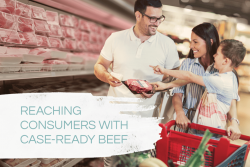
Post-COVID-19 Foodservice Predictions, and How to Create a Great “First” Impression
Mar 12, 2021
The foodservice industry has experienced no shortage of challenges as a result of the pandemic, and the question of how to fully reopen safely—in a way that both follows regulations and replicates pre-pandemic times—is perhaps the biggest one. Regulations for restaurants in the U.S. vary widely by region, state, and even county, and they are continuously changing. Restauranteurs with mid and upscale establishments in particular have had to pivot more often than not and find creative ways to reach their customers. Whether offering curbside pick-up, creating take-home meal kits for customers to cook themselves, or utilizing a delivery service, the pressure to help restaurant-goers create chef-worthy meals at home has remained high throughout 2020 and early into 2021.
Fortunately, as more Americans gain access to the COVID-19 vaccine, regulations are beginning to loosen, and we’re finally seeing some light at the end of the tunnel for being able to return to normal operations (or, at the very least, operating at a higher capacity than in the recent past).
If you’re a restaurant owner or foodservice professional in the process of reopening your doors, here are some things you’ll want to consider and ways to enhance the guest experience as you do.
1. Curbside pickup and delivery services: are they really here to stay?
Curbside pickup and delivery services are now well beyond commonplace, and it’s easy to assume they’ll last after the pandemic gets under control. Even prior to the pandemic, experts predicted that delivery services like GrubHub and Uber Eats would steal the show as consumers enjoy the convenience of delivery from a wider range of restaurant options that they wouldn’t have otherwise.
However, at least for restaurants other than Quick Service Restaurants (QSRs), we’re finding that those services—and even curbside pickup or meal kits—aren’t sustainable stand-ins for coming to the physical establishment. It can be difficult to ensure a quality dining experience with various packaging options or when the food needs to be transported. In the case of meal kits, consumers might not be able to prepare the dish effectively. In addition, outside of the perceived quality of the meal, consumers are losing the experience that comes with it—they can’t replicate the ambiance of the establishment or the “going out” feeling in their own homes. Not to mention the downsides for restaurateurs, such as lost profit margins, lower check rings, and staggering fees for using the service.
We predict that as we return to being able to offer indoor dining, mid and upscale restaurateurs will start to distance themselves from these services and refocus on what they can do to reach guests at their physical establishment and funnel their energies into those efforts.
2. So, what will customers want from restaurants after COVID-19?
While some customers may still utilize delivery and curbside pickup, once they’re able to safely visit establishments with their friends and family, it’s safe to assume guests will be most excited about getting out. That is, they’ll value the environment and the experience just as much as the meal itself.
Since the pandemic reached the U.S. last year, guests have had an abbreviated experience of the restaurants in their area, and they’ve likely not been able to experience new establishments yet. That means patrons will be looking to indulge, and they will be even likelier to do so than in the past.

Anything restaurants can do to add to the experience will be critical in making a lasting impression upon reopening, especially if that experience may still be different from what guests expected in the past (for example, having fewer interactions with servers or being required to wear masks). Getting menu offerings and the eating experience right will be also be crucial, but creating an energizing environment will be equally, if not more, important.
3. What Retail Trends Can Tell Us about Consumer Demand in Foodservice
Dining trends in foodservice have been all over the board as a result of fluctuating foot traffic, changes in how restaurants operate, and shifting regulations throughout the country. However, retail trends have been somewhat easier to measure and more consistent, meaning they can give us some unique insights about consumer preferences and what we can predict as consumers return to their favorite dining establishments.
In retail, we’ve seen a jump in sales as more consumers dined at home, but as the pandemic eases, we can anticipate those same consumers will flock back to their favorite establishments—and be eager to do so. Following the initial stocking up on meats, frozen foods, and shelf-stable goods that we witnessed in early 2020, shoppers quickly gravitated toward fresh and healthy foods, as well as products that helped them create fine dining at home. We saw a higher demand for claims-based meats in all categories, whether beef, chicken, or pork, as consumers sought out healthy options and continued to prioritize animal welfare and sustainability.
That demand remained strong throughout the year, with overall meat dollar sales up 18.4%[1]. Claims-based meat sales grew by nearly 32% during the pandemic period, with no antibiotics ever, free range, and products with animal welfare claims coming out on top and beef sales outperforming other proteins.[2]
These trends gave retailers a huge boost when it came to total basket rings in their stores. Claims-based meats add a higher profit margin, but they also have ripple effects throughout the store—customers who purchase claims-based meats are also more likely to purchase other specialty products, like organic vegetables, artisanal cheeses, and expensive wine.
According to IRI, beef added three times more dollar sales to stores than any category, remaining a top dollar-generator throughout the pandemic. Read more about this and other industry trends.
For foodservice, these are valuable insights, as these consumers are going to want similar novelty experiences and a backstory about where their food comes from when they’re able to frequent restaurants again. These trends show us that consumers have an interest in pairing high-quality meats with other specialty items, meaning restaurants have an opportunity to add to the average check ring—waitstaff can upsell sides, beverages, and items like steak toppers, for example. While menu innovations may be further down the road for restauranteurs just starting to reopen, it’s something to keep top-of-mind as we find our bearings and move into 2021. Mintel predicts that in 2021 and beyond, the food industry will be driven by menu and operational innovation.
Tips for Reopening Your Establishment
Given the trends we’ve witnessed in retail and the excitement across the board for returning to restaurants, you’ll want to prioritize both the eating experience and the environment you create for your guests. As social distancing and wearing masks are still important for reducing the risk of spreading the virus, think of creative ways to create connections with your guests and give them the story behind your establishment and the foods you offer.

Taking advantage of QR codes or other digital menu options can be helpful in providing the nutritional information and health benefits of your offerings, but they also give you the opportunity to add romance to the story behind them. You can highlight where the food was raised and produced, for example, or educate the customer on unique product attributes (for example, what “Natural” means). These tools can be invaluable in adding to the experience while having fewer interactions between guest and server.
Find a partner who can act as a training resource, menu guide, and more.
In the end, you can set your establishment up for success by partnering with distributors and suppliers who can be an asset in the reopening process. Seek out partners who can help you understand new regulations, bring your staff up to speed on front-of-house and back-of-house training, who can help you innovate or consolidate your menu, or offer marketing assistance.
At Aspen Ridge® Natural Angus Beef, we pride ourselves on going beyond being a food producer. We want to help our foodservice and retail partners succeed and are willing to work with you to find innovative ways to reach your customers. Get in touch with us today for more insights on how to reopen your restaurant successfully or to learn more about Aspen Ridge products for foodservice.
JBS Beef Foodservice Team
[1] “Meat department closes out 2020 18.4% above 2019 levels,” National Provisioner, 2021.
[2] “Understanding the Fresh Market,” IRI, 2020.



